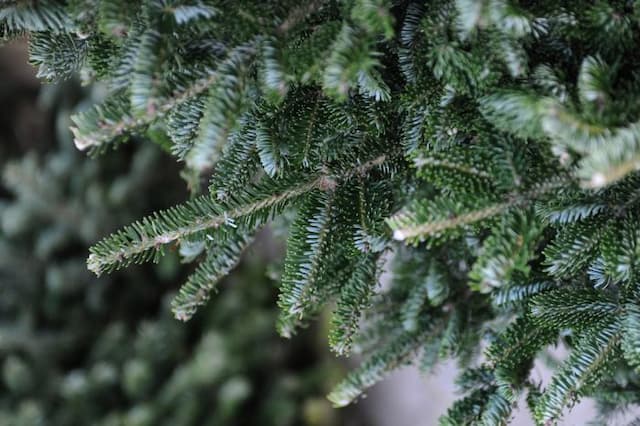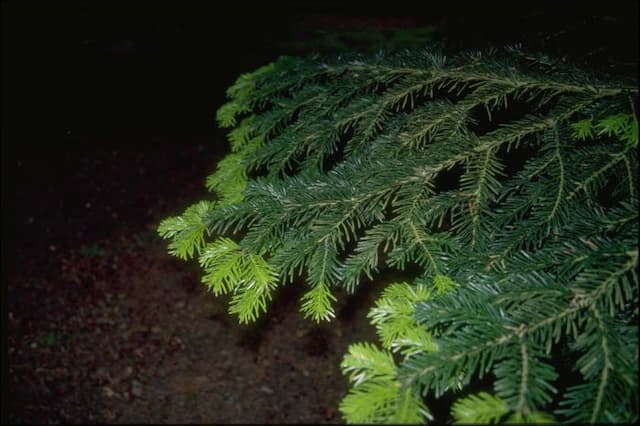White Spruce Picea glauca 'Arneson's Blue Variegated' (v)

ABOUT
The Picea glauca 'Arneson's Blue Variegated', more commonly known as the white spruce, is distinctive for its attractive foliage that brings a unique coloration to the landscape. Unlike the typical green hues found in many conifers, this variegated variety showcases a blend of colors. The needles of this plant exhibit a striking combination of blue and green, with the blue often presenting as a soft, silvery-blue shade that is particularly eye-catching. This variegation adds depth and contrast to its appearance. The overall form of the white spruce is a pyramidal shape, typical of many members of the spruce family, creating a structured and somewhat formal appearance. The needles are arranged around the branches, contributing to the dense and lush nature of this conifer. As an evergreen, this plant maintains its coloration throughout the year, making it an excellent choice for adding winter interest to a garden or landscape. In addition to the color of its needles, the cones of the white spruce may offer ornamental value. The cones are modest and unobtrusive, but upon closer inspection, they can be appreciated for their intricate scales and overall design. The variegated foliage and pyramidal form, coupled with its subtle cones, make the variegated white spruce a captivating specimen for visual interest in a range of garden settings, from standalone specimens to components of larger conifer collections or evergreen borders.
About this plant
 Names
NamesFamily
Pinaceae.
Synonyms
White Spruce, Canadian Spruce, Skunk Spruce, Cat Spruce, Arneson's Blue Variegated Spruce.
Common names
Picea glauca 'Arneson's Blue Variegated'
 Toxicity
ToxicityTo humans
The common name of Picea glauca 'Arneson's Blue Variegated' is the white spruce. White spruce is generally not considered toxic to humans. However, like many other plants, it could potentially cause minor irritations or allergic reactions in some individuals when handled or ingested. These are not typical responses and serious toxicity from consuming parts of the white spruce is rare.
To pets
The white spruce is generally not toxic to pets. However, ingestion of significant quantities of needles can potentially lead to gastrointestinal irritation or obstruction, mainly due to the physical nature of the needles rather than chemical toxicity. It's always prudent to discourage pets from ingesting plant material, even from plants that are not known to be toxic.
 Characteristics
CharacteristicsLife cycle
Perennials
Foliage type
Evergreen
Color of leaves
Mixed
Height
10-15 feet (3-4.6 meters)
Spread
4-6 feet (1.2-1.8 meters)
Plant type
Tree
Hardiness zones
3
Native area
North America
Benefits
 General Benefits
General Benefits- Aesthetic Appeal: The Picea glauca 'Arneson's Blue Variegated', also known as White Spruce, adds visual interest to a landscape with its striking blue-green, variegated foliage.
- Year-Round Interest: Being an evergreen plant, it provides color and structural interest throughout all seasons.
- Limited Growth: Its moderate growth rate and eventual moderate size can be suitable for smaller gardens or as a specimen tree in larger landscapes.
- Wildlife Habitat: White Spruce offers shelter and nesting sites for birds and other wildlife.
- Windbreak: It can be used as part of a windbreak or shelterbelt, helping to protect more sensitive plants and reduce wind erosion.
- Privacy Screen: With its dense growth, it can serve as a privacy screen or natural fence between properties.
- Cold Tolerant: It is well adapted to cold climates, capable of withstanding harsh winters.
- Soil Versatility: This plant is tolerant of various soil types, albeit preferring well-drained, acidic soil.
- Low Maintenance: Once established, White Spruce requires minimal care, making it suitable for gardeners seeking low-maintenance plants.
 Medical Properties
Medical PropertiesThis plant is not used for medical purposes.
 Air-purifying Qualities
Air-purifying QualitiesThis plant is not specifically known for air purifying qualities.
 Other Uses
Other Uses- White Spruce needles can be used as a natural stuffing for small pillows or plush toys, as they can retain their shape and offer a subtle woodsy scent.
- The wood of White Spruce can be crafted into musical instruments like violins and guitars, due to its resonance and tonal qualities.
- White Spruce branches are often used in winter floral arrangements and wreaths, bringing a touch of evergreen beauty and festive charm to holiday decor.
- Sap extracted from White Spruce can be used as a natural adhesive or resin in traditional crafting due to its sticky properties.
- The inner bark of White Spruce, when dried and ground, can be incorporated into homemade soaps for exfoliation and its mild pine aroma.
- You can use the wood chips or sawdust of White Spruce for smoking meats to impart a unique flavor profile distinctive to the wood's essence.
- White Spruce cones can be dipped in wax to create eco-friendly fire starters for camping or wood stoves.
- The boughs of White Spruce are sometimes used in saunas or steam rooms for their aromatic properties when placed over hot stones or stove units.
- White Spruce can be cultivated into living fences or privacy screens, offering a natural barrier that's both decorative and functional.
- The tannins in White Spruce bark can be used in the tanning process of leather, providing an organic method for leather hardening and coloring.
Interesting Facts
 Feng Shui
Feng ShuiThe White Spruce is not used in Feng Shui practice.
 Zodiac Sign Compitability
Zodiac Sign CompitabilityThe White Spruce is not used in astrology practice.
 Plant Symbolism
Plant Symbolism- Endurance: Picea glauca, commonly known as the White spruce, can withstand cold climates and poor conditions, symbolizing resilience and the ability to endure hardships.
- Purity: The color white is often associated with purity and innocence, which is reflected in the white spruce's common name and can symbolize a fresh, clean start or purity of intention.
- Peace: Evergreens like the white spruce are often symbols of peace and tranquility due to their perennial nature and the calm green hues they bring to landscapes even in winter.
- Protection: As an evergreen, the white spruce stands guard over the landscape year-round, representing protection and security through all seasons.
- Growth: The white spruce, as a tree, is a natural symbol of growth, both physical and spiritual, pointing toward higher aspirations and personal development.
 Water
WaterThe White Spruce should be watered deeply and infrequently to mimic natural rainfall, allowing the soil to dry out slightly between waterings. A guideline for young trees is to provide about 2 gallons of water per week, adjusting for rainfall, climate, and soil conditions. In the growing season, water more frequently, while in winter, water less. It's important not to overwater, as White Spruce does not like waterlogged soil. Adult trees are drought-resistant and typically require less frequent watering.
 Light
LightWhite Spruce prefers full sun to partial shade, thriving best in locations where it can receive at least 4 to 6 hours of direct sunlight daily. It will perform well in a spot that offers morning sun and afternoon shade, or vice versa, but it is adaptable to different light conditions as long as it gets enough light to sustain its growth.
 Temperature
TemperatureWhite Spruce is hardy and can withstand cold temperatures, thriving in a range between -40 to 70 degrees Fahrenheit. While it can survive extreme colds down to about -50 degrees Fahrenheit, prolonged exposure to temperatures above 75 degrees Fahrenheit can stress the plant. It is ideally suited for cooler climates and retains its health and vigor within this temperature range.
 Pruning
PruningWhite Spruce requires little pruning, mainly to remove dead or damaged branches, or to shape young plants for a desired form. Pruning should occur in late winter or early spring before new growth starts. It is not recommended to prune frequently or too late in the season, as this can hinder the natural form and health of the tree.
 Cleaning
CleaningNot needed
 Soil
SoilThe White Spruce 'Arneson's Blue Variegated' prefers a well-draining, loamy soil mix with a slightly acidic to neutral pH, typically between 5.5 and 7.0. A mixture consisting of peat moss, compost, and perlite or coarse sand can provide the necessary drainage and nutrients for optimal growth.
 Repotting
RepottingWhite Spruce 'Arneson's Blue Variegated', being a slow-growing conifer, does not require frequent repotting. Repotting can be done every 4-5 years or when the tree becomes root-bound, usually best performed in early spring before new growth begins.
 Humidity & Misting
Humidity & MistingWhite Spruce 'Arneson's Blue Variegated' tolerates a wide range of humidity levels but prefers average to high humidity found in its natural outdoor habitat. Outdoor ambient humidity is typically sufficient, and the plant does not have specific indoor humidity requirements.
 Suitable locations
Suitable locationsIndoor
Provide bright light, cool temps, and avoid dry heat for indoor growth.
Outdoor
Plant in full sun, well-drained soil, and protect from harsh winds.
Hardiness zone
2-6 USDA.
 Life cycle
Life cyclePicea glauca 'Arneson's Blue Variegated', commonly known as White Spruce, begins its life as a seed, which requires a period of cold stratification to germinate. Upon sprouting, the seedling develops into a young plant, establishing its root system and a stem with juvenile needles that are more resistant to cold and desiccation. As the White Spruce matures, it develops into a sapling with adult foliage that is distinctively blue-green with variegated patterns. It then enters a long vegetative phase, where it grows steadily in height and width, developing a conical shape characteristic of spruce trees. After reaching maturity, which can take several years, it starts producing cones annually, which are pollinated by the wind, resulting in the production of new seeds. Finally, after decades or even centuries, the White Spruce naturally senesces and dies, completing its life cycle, with its seeds continuing the lineage.
 Propogation
PropogationPropogation time
Spring to Early Summer
The most popular method of propagating the White Spruce 'Arneson's Blue Variegated' is through cuttings, typically taken in summer when the plant's growth is most active. A healthy, semi-hardwood branch segment of about 4 to 6 inches (10 to 15 cm) long is cut from the parent plant. The cut end is often dipped in rooting hormone to encourage root development and then planted in a well-draining potting mix. The cutting should be kept in a humid environment with indirect light until roots have formed, which can take several weeks. Once the cutting has established a strong root system, it can be transplanted to a more permanent location outdoors.








